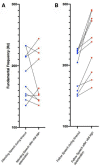Acoustic analysis of surgeons' voices to assess change in the stress response during surgical in situ simulation
- PMID: 35520977
- PMCID: PMC8936944
- DOI: 10.1136/bmjstel-2020-000727
Acoustic analysis of surgeons' voices to assess change in the stress response during surgical in situ simulation
Abstract
Introduction: Stress may serve as an adjunct (challenge) or hindrance (threat) to the learning process. Determining the effect of an individual's response to situational demands in either a real or simulated situation may enable optimisation of the learning environment. Studies of acoustic analysis suggest that mean fundamental frequency and formant frequencies of voice vary with an individual's response during stressful events. This hypothesis is reviewed within the otolaryngology (ORL) simulation environment to assess whether acoustic analysis could be used as a tool to determine participants' stress response and cognitive load in medical simulation. Such an assessment could lead to optimisation of the learning environment.
Methodology: ORL simulation scenarios were performed to teach the participants teamwork and refine clinical skills. Each was performed in an actual operating room (OR) environment (in situ) with a multidisciplinary team consisting of ORL surgeons, OR nurses and anaesthesiologists. Ten of the scenarios were led by an ORL attending and ten were led by an ORL fellow. The vocal communication of each of the 20 individual leaders was analysed using a long-term pitch analysis PRAAT software (autocorrelation method) to obtain mean fundamental frequency (F0) and first four formant frequencies (F1, F2, F3 and F4). In reviewing individual scenarios, each leader's voice was analysed during a non-stressful environment (WHO sign-out procedure) and compared with their voice during a stressful portion of the scenario (responding to deteriorating oxygen saturations in the manikin).
Results: The mean unstressed F0 for the male voice was 161.4 Hz and for the female voice was 217.9 Hz. The mean fundamental frequency of speech in the ORL fellow (lead surgeon) group increased by 34.5 Hz between the scenario's baseline and stressful portions. This was significantly different to the mean change of -0.5 Hz noted in the attending group (p=0.01). No changes were seen in F1, F2, F3 or F4.
Conclusions: This study demonstrates a method of acoustic analysis of the voices of participants taking part in medical simulations. It suggests acoustic analysis of participants may offer a simple, non-invasive, non-intrusive adjunct in evaluating and titrating the stress response during simulation.
Keywords: In Situ; cognitive load; communication; education; medical; otolaryngology.
© Author(s) (or their employer(s)) 2021. No commercial re-use. See rights and permissions. Published by BMJ.
Conflict of interest statement
Competing interests: None declared.
Figures





References
-
- Yerkes RM, Dodson JD. The relation of strength of stimulus to rapidity of habit-formation. J Comp Neurol Psychol 1908;18:459–82. 10.1002/cne.920180503 - DOI
-
- Teigen KH, Dodson Y. ‘A law for all seasons’. Theory & Psychology 1994;4:525–47.
LinkOut - more resources
Full Text Sources
Miscellaneous
